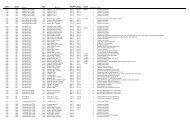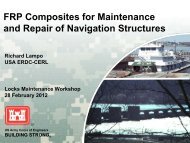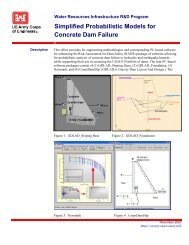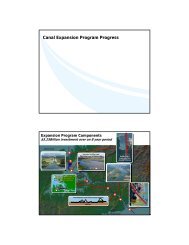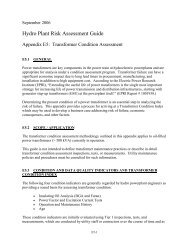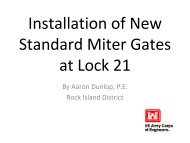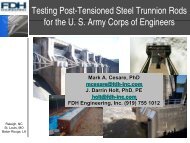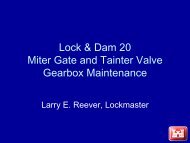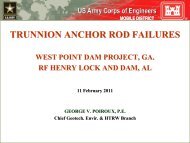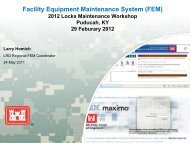Hydro Plant Risk Assessment Guide
Hydro Plant Risk Assessment Guide
Hydro Plant Risk Assessment Guide
Create successful ePaper yourself
Turn your PDF publications into a flip-book with our unique Google optimized e-Paper software.
Table 6 – Intake Valve Operator (Hydraulic or Electric) Physical Condition<br />
Results<br />
Seals, stems, cylinders, hydraulic system, gate position indicators,<br />
and controls are in good condition with replacement parts available;<br />
backup power is available and tested regularly; slow-down mode has<br />
been tested and verified; pressure differential indicators<br />
up/downstream are operational and tested; operational testing<br />
performed on an annual basis; the system is exercised regularly.<br />
Seals, stems, cylinders, hydraulic system, gate position indicators,<br />
and controls are updated or in good condition; backup power is<br />
available; slow-down mode functions but could use a minor<br />
adjustment; pressure differential indicators up/downstream are<br />
operational but not calibrated; the system is exercised frequently.<br />
Seals, stems, cylinders, hydraulic system, gate position indicators,<br />
and controls are in fair condition; backup power is not regularly<br />
tested; slow-down mode functions but could use a minor adjustment;<br />
pressure differential indicators up/downstream are operational but not<br />
calibrated. The timed cycle of operation has changed slightly; the<br />
system is exercised rarely.<br />
Seals, stems, cylinders, hydraulic system, gate position indicators,<br />
and controls are in poor condition; backup power is not available or<br />
not reliable; slow-down mode and limit switches are out of<br />
adjustment; pressure differential indicators up/downstream are not<br />
functioning; the timed cycle of operation has changed significantly;<br />
the system is never exercised.<br />
Intake Valve Condition<br />
Indicator Score<br />
3<br />
2<br />
1<br />
0<br />
Condition Indicator 4 – Operations History<br />
Normal operations are defined as meeting the requirements of the gate or valve’s operational<br />
design criteria. Examples of deficiencies include: excessive gate drift, significant changes in<br />
travel time and pressures, abnormal noise or vibration, changes to the configuration that would<br />
impact the availability of emergency closure within the originally-specified time period. Backup<br />
power or reliability of the power source is important for reliable operations of the device under<br />
emergency situations.<br />
Operational Criteria:<br />
• Does the existing system design meet closure rate requirements (e.g., Army Corps of<br />
Engineers-required less than 10-minute closure for gates; less than 2-minute closure for<br />
valves)<br />
• Does the existing system design meet the unbalanced gate closure requirements<br />
• Does the gate/valve position indicator work<br />
• Does the remote closure capability (if present) operate correctly<br />
• Does the annunciation system give adequate warning of a gate closure<br />
E11-11



